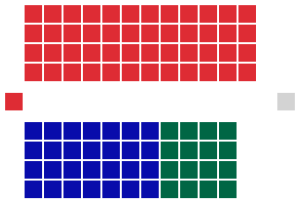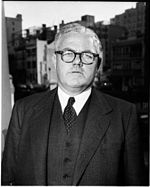New South Wales state election, 1959
|
|
||||||||||||||||||||||||||||||||||
|---|---|---|---|---|---|---|---|---|---|---|---|---|---|---|---|---|---|---|---|---|---|---|---|---|---|---|---|---|---|---|---|---|---|---|
|
||||||||||||||||||||||||||||||||||
|
All 94 seats in the New South Wales Legislative Assembly 48 Assembly seats were needed for a majority |
||||||||||||||||||||||||||||||||||
|
||||||||||||||||||||||||||||||||||

Legislative Assembly after the election
|
||||||||||||||||||||||||||||||||||
|
||||||||||||||||||||||||||||||||||
The 1959 New South Wales state election was held on 21 March 1959. It was conducted in single member constituencies with compulsory preferential voting and was held on boundaries created at a 1957 redistribution. The election was for all of the 94 seats in the Legislative Assembly.
A redistribution of electoral boundaries was undertaken in 1957 based on the 1954 Australian Census. Reflecting population shifts from the eastern and inner western suburbs of Sydney to western Sydney, two safe Liberal seats, Ashfield and Croydon were combined into the seat of Ashfield-Croydon and two safe Labor seats, Paddington and Waverley were combined into Paddington-Waverley. Merrylands was created in Western Sydney and was a notional Labor seat. In addition, the marginal seat of Parramatta became a safe Labor seat. In southern Sydney, the marginal seat of Sutherland became a safe Labor seat by the creation of Cronulla which had a notional Liberal majority. The effect of the redistribution was to increase Labor's numbers by 1.
...
Wikipedia

